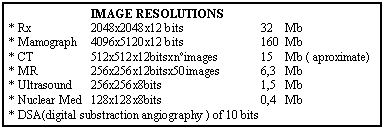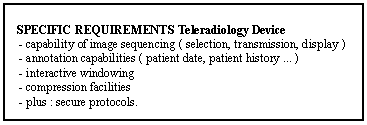
This chapter cover the rules practicing Telemedicine in the different recognized Telemedicine services including not only those partially standardized but also those still under devellopment
TELERADIOLOGY
C.RUGGIERO
Teleradiology can be defined as the transmission of radiological images from one location to another, for the purpose of interpretation and/or consultation

Basic parts of a Teleradiology system:
I.- Image acquisition
II.- Display section
III.- Communication network
IV.- Interpretation section
I.- Image adquisition
a) Film digitizer ( Laser , CCD , phosphor storage plates )
b) Frame grabbing from an analog input

Image standard up to now in Radiology applications is DICOM v3 ( see Chapter 2 )
II.- Display systems
ACR norms( 199 ) for a Teleradiology system: ( ACR= American College Radiologists )
a) Small matrix applications ( CT,MRI, ultrasound,nuclear med,fluorography )0.5 x 0.5 K x 8bits
- digitized and
- display with accurate reproduction original study (series)
b) Large matrix ( Rx films, CR=computer radiology )
2Kx 2Kx 12bits digitizer
2Kx 2Kx 8bits display that require
- Interactive windowing
- Image analysis: inversion, rotation,fuctions
- Accurate measurements
III.- Communication network .
Performance depend on :
number of images to send
size of the files ( compression )
peak of activity of the network
IV.- Interpretation section

TELEPATHOLOGY
O.FERRER-ROCA
Pathologist based their diagnosis on colored speciments and detection of controled artefacts induced in an otherwise transparent and not visually detected speciments-
The training period required to modify the previous control scenario to a more constrained one in which sampling , focus and colors are much more limited ( such in Teleconsultation cases ) is arround 1,5 years, and have to be taken into account when the so called " expertisse consultation " is considered.

1.- MULTIMEDIA DATA BASE
Is a preliminary condition, since no diagnosis can be done without a clinical history and knowledge of previous biopsies . When archieved in the referal laboratory , they should be available ( in the data base ) for comparison purposes.
2.- COLOR IMAGES OF SUFFICIENT RESOLUTION
Diagnosis in pathology are base on color that with 8 bits dinamic range produce sufficient information.
Neverthelless sampling of image ( spatial resolution ) is the most important parameter for an accurate visual perception . This fact introduce variability on the minimum requirements for a capture system depending on the microscopic power used.
This is also directly linck to the capability of Pathology Images to support lossy compression algorithms. If minimum requirements on spatial resolution are respected, compression is possible without sensible loss of visual information.
3.- INTERACTIVE CONTROL OF COLOR
Missinterpretation of color at distance is one of the main causes of errors. Therefore a minimum knowledge of the COLOR THEORY is required to understand the need of interactivity and in which way it operates
A.SOUSA- Color Theory
5.- CONTROLED SAMPLING
Include a wide range of capabilities , from the one of a distant robotic microcopic systems ( not expensive and not technically complicated since many microscopes have a motorized stage ) in which sampling can be done on the diagnostic site, up to the simplest one in which a low power images are sent with the marks on where the higher power images will be taken.
The same statment can be applied to macroscopical images using a motorized surveillance camara
6.- SECURITY AND CONFIDENTIALITY TOOLS
Digital signature, authentication of data and control and register of any modification is mandatory in a diagnostic system which is based on the data available ( see Chapter 8 )
This will joint the organizational requirements to use the system by a staff that have to be aware of the information protection techniques for manipulating personal sensible data, as well as liability issues link to the task ( see Chapter 9 ).
Not strictly required , but obviously very important for an efficient and funtional system is the Appointment Management in cases of " on line " supervision or diagnosis . This can be done :
- through a STUDIO organization ( see Chapter 7 ) or
- on a personal computer based system, by electronic means.
Finally the CSCW do not seems to be an essential feature for a Telepathology system.
Part or total reproduction not allow without permission
Revisado: martes, 10 junio 1997.
Con el soporte informático y de comunicaciones
del CICEI, Universidad
de Las Palmas de Gran Canaria